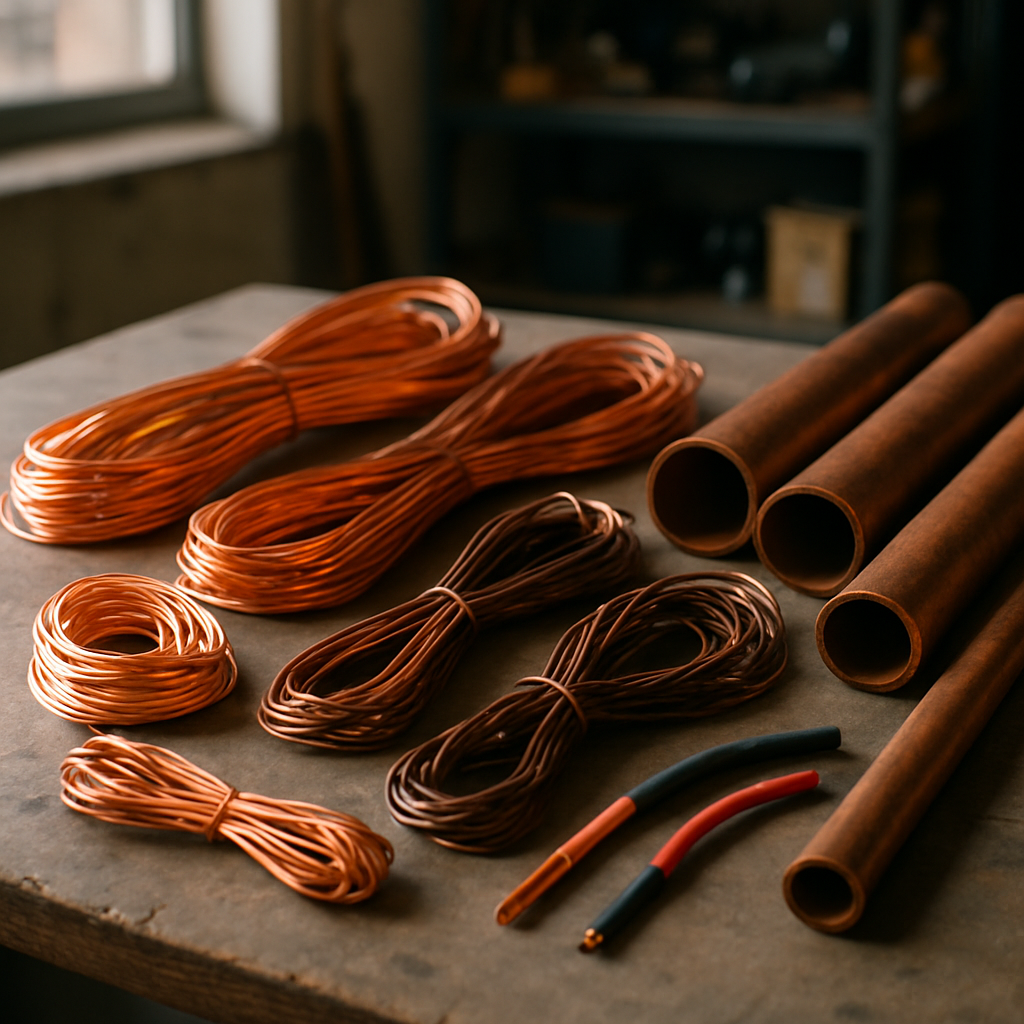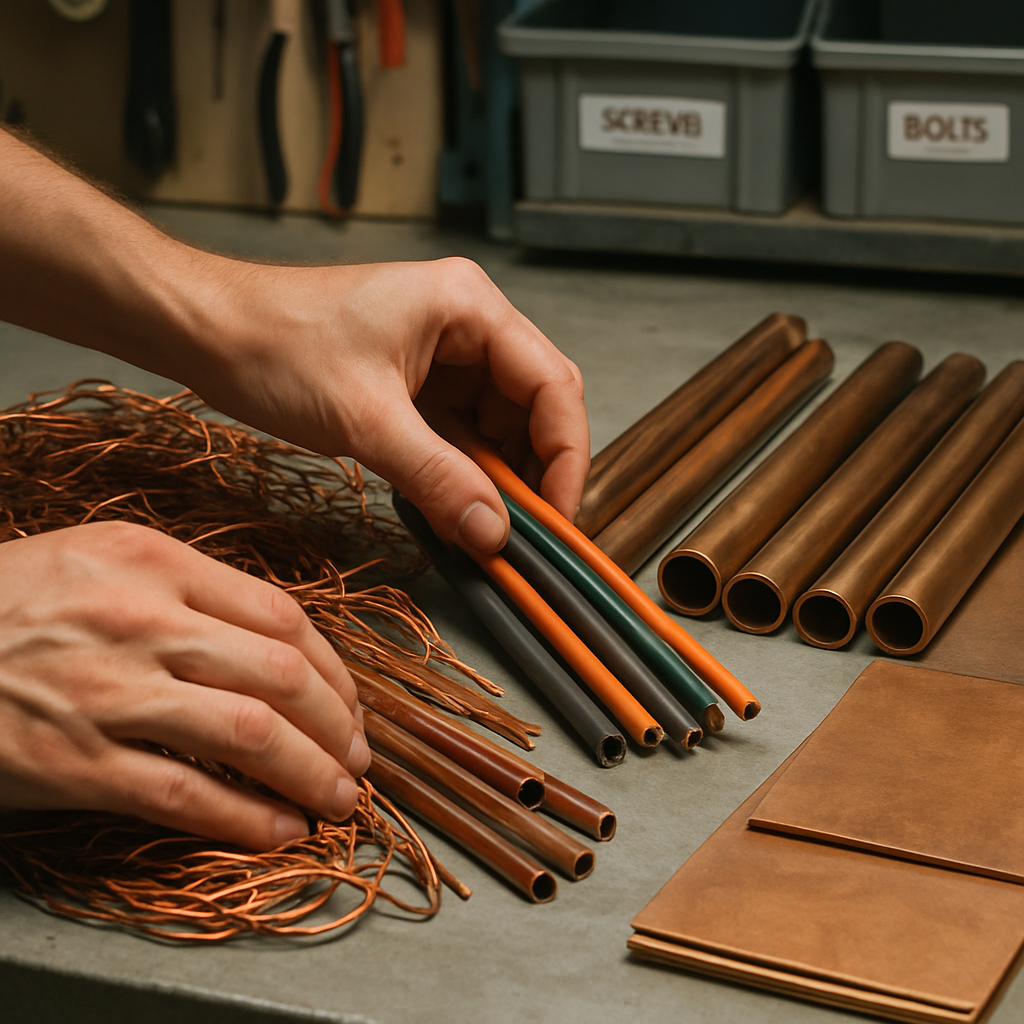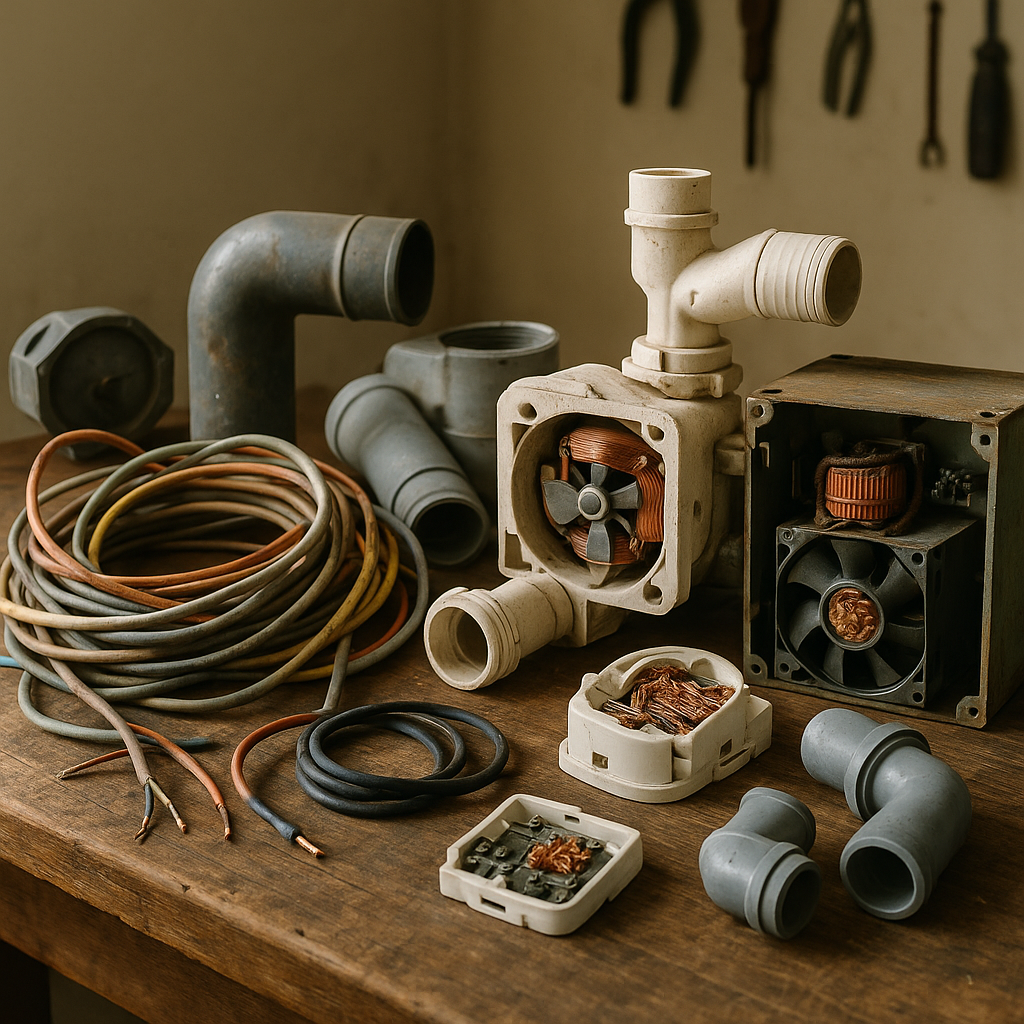5901 Botham Jean Blvd, Dallas, TX 75215
What is Scrap Copper and Why is it Valuable?
June 29, 2025The tangle of old wiring in your garage or the discolored pipes removed during a bathroom renovation aren’t just waste materials. They represent scrap copper, one of the most sought-after recyclable metals globally. Scrap copper includes any copper-containing materials that have reached the end of their intended use, such as electrical wiring, plumbing pipes, roofing elements, and components from discarded appliances and electronics.
Copper holds significant value in the recycling industry due to its remarkable physical properties. Unlike many materials that degrade with reuse, copper retains its electrical conductivity, corrosion resistance, and malleability even after multiple recycling cycles. This recyclability makes it a cornerstone material in our increasingly sustainability-focused economy.
The financial value of scrap copper is equally impressive. Recycled copper typically fetches 90-95% of the price of newly mined copper on the market. This high valuation exists because recycling copper requires significantly less energy—up to 85% less—than extracting and processing it from raw ore. Industries in construction, electronics manufacturing, renewable energy, and transportation all depend on reliable copper supplies, creating a consistent demand that keeps scrap copper prices robust year after year.
What Are the Different Grades of Scrap Copper?

In the copper recycling industry, scrap copper is categorized based on purity, appearance, and quality, which directly influences its value. Understanding these grades is essential for maximizing profits.
Each copper grade fetches a different price in the market, with higher-purity grades attracting premium rates. Let’s explore the main classifications of scrap copper and what sets them apart.
Bare Bright Copper
Bare bright copper is at the top of the grading hierarchy. This premium grade is instantly recognizable by its shiny, bright appearance. Scrap yards and recyclers prefer bare bright copper for several key reasons:
- Consists of unalloyed, uncoated copper wire or cable (typically 16-gauge thickness or larger)
- Contains 99%+ copper purity without contaminants
- Free from paint, solder, oxidation, or any other impurities
- Commonly sourced from electrical wiring, bus bars, and ground wire
- Commands the highest price per pound in the recycling market
Bare bright copper must be completely stripped of insulation and free from tarnishing. Copper piping does not qualify for this classification, regardless of its condition.
#1 Copper
#1 copper is the second most valuable grade. While still high-quality, it allows for minor imperfections:
- Contains 95-99% copper content
- May show slight oxidation but remains mostly clean
- Typically includes bus bars, clippings, or wire of at least 1/16th inch diameter
- Must be unalloyed and free from excessive paint or solder
- Clean copper piping without fittings or attachments fits this category
This grade includes copper that remains clean and pure but may not meet the pristine standards required for the bare bright classification.
#2 Copper
#2 copper represents a third tier in copper quality with more visible imperfections:
- Contains approximately 94-96% copper content
- Features noticeable oxidation, paint, coatings, or solder
- Often appears darker or tarnished compared to higher grades
- Includes miscellaneous unalloyed wire or solid copper with visible impurities
- Commonly found in used plumbing pipes, roofing materials, or components with soldered joints
Despite its lower purity, #2 copper remains valuable, though it commands a lower price than higher grades.
Insulated Copper Wire
Insulated copper wire forms a separate category with its subclassifications. The value depends mainly on copper recovery potential:
- High-grade #1 insulated wire: Clean, unalloyed copper wire with thin insulation and high copper content; often found in electrical wiring
- Low-grade #2 insulated wire: Wire with heavier insulation and lower copper content; commonly found in appliance cords and telephone wires
The value of insulated copper wire is determined by the copper-to-insulation ratio. Stripping the insulation significantly increases its value, as bare copper always commands a higher price than insulated wire.
When recycling copper, sorting by grade ensures maximum value for your scrap. Many recyclers offer considerably more for properly separated copper compared to mixed loads. For electrical contractors and plumbers who regularly handle copper materials, understanding these distinctions can significantly impact profitability when recycling excess materials.
How Can You Visually Identify Different Types of Scrap Copper?

Visual identification is an effective way to categorize different types of scrap copper before recycling. Recognizing distinct characteristics can help maximize value and ensure proper sorting of your copper materials.
Bare Bright Copper
Bare bright copper stands out with its reddish-brown color and highly reflective surface. This premium grade copper has a bright and shiny appearance that almost glows when exposed to light. Its surface is clean, free from oxidation, and maintains a consistent luster.
This highest-grade copper typically comes from electrical wiring, bus bars, and ground wires that are at least 16-gauge thick. Its visual purity reflects a high copper content—usually 99% or more—making it easily recognizable by its shine and uniform color.
#1 Copper
#1 copper retains much of the reddish-brown color but may show slight tarnishing or minor oxidation. While not as reflective as bare bright copper, it still presents a clean appearance with minimal impurities.
This grade commonly comes from plumbing pipes, copper sheet metal, and bus bars. A quick visual inspection reveals a slightly duller finish compared to bare bright copper, though it remains clean and uncoated. The copper content typically ranges between 95-99%, with slight discoloration as the main visual indicator distinguishing it from bare bright.
#2 Copper
#2 copper has a noticeably darker and less reflective appearance. Its surface often appears dirtier, with visible oxidation, paint, coatings, or solder. The reddish-brown color may be partially obscured by these impurities.
This grade is frequently sourced from used plumbing pipes, copper with soldered joints, and roofing materials. Visual indicators include darker coloration and obvious surface contamination. Green patina formation may be noticed in some areas, especially on older copper exposed to the elements.
Insulated Copper Wire
Insulated copper wire is identifiable by its outer covering of plastic, rubber, or other insulating materials. The copper itself isn’t visible without stripping or cutting the insulation. The value varies depending on the thickness of the copper conductor inside relative to the insulation.
These wires come in various colors based on their insulation type, ranging from black and white to multi-colored coverings. Wire thickness provides clues about the copper content—thicker wires generally contain more copper relative to their insulation.
When evaluating insulated copper wire, examine the ends where the copper conductor might be visible or estimate the wire’s weight to gauge the copper-to-insulation ratio.
What Are Some Common Sources of Scrap Copper?

Scrap copper is abundant in our everyday surroundings, often hiding in plain sight. Identifying these valuable sources can help businesses and individuals maximize recycling efforts while recovering significant value from materials that might otherwise end up in landfills.
Construction and Demolition Sites
Construction and demolition projects offer rich opportunities for copper recovery. When buildings undergo renovation or demolition, substantial amounts of copper wiring, conduit, and plumbing pipes become available for recycling.
Copper plumbing has been the standard in residential and commercial buildings for decades due to its durability and resistance to corrosion. These pipes, when removed during renovations, represent a significant source of high-quality scrap copper.
Electrical wiring from walls, ceilings, and underground installations contains copper conductors wrapped in plastic insulation. Stripping this insulation reveals valuable bare copper wire that recyclers eagerly purchase.
Household Appliances and HVAC Systems
Many household appliances contain substantial amounts of copper components. Air conditioning units and refrigeration systems are particularly valuable sources, containing copper tubing and condenser coils.
Other appliances like washing machines, dryers, and dishwashers incorporate copper in their motors, pumps, and electrical systems. Even smaller kitchen appliances such as microwaves and blenders contain copper wiring and components worth salvaging.
Water heaters present another excellent source of scrap copper, with older models containing copper heating elements and connecting pipes that can be recovered when units are replaced.
Electronics and Computing Equipment
The electronics recycling stream yields considerable amounts of copper. Circuit boards from computers, televisions, and mobile devices contain copper traces and components recoverable through specialized processing.
Computer power supplies and transformers contain copper windings that make them valuable for recycling. Older CRT monitors and televisions also contain copper yokes and wiring harnesses.
Server farms and data centers that upgrade their infrastructure regularly generate substantial quantities of copper-rich cables, connectors, and components.
Automotive and Transportation Sources
Vehicles contain numerous copper components that can be recovered when they reach end-of-life status. Radiators, particularly from older vehicles, have copper cores highly valued by recyclers.
Starters, alternators, and electric motors in vehicles incorporate copper windings. Even the wiring harness throughout a vehicle contains significant amounts of copper worth recovering.
With the prevalence of electric vehicles, copper recovery from batteries, motors, and charging systems represents a growing opportunity in the automotive recycling sector.
Industrial Equipment and Infrastructure
Industrial equipment often contains substantial copper components in motors, transformers, and control systems. When facilities upgrade or decommission equipment, these become valuable sources of scrap copper.
Electrical infrastructure such as transformers, switchgear, and power distribution equipment contains large quantities of copper. Utility companies regularly generate copper scrap when upgrading power networks.
Copper is also found in industrial piping, heat exchangers, and process equipment across manufacturing facilities, chemical plants, and refineries.
Conclusion: Maximizing Value When Recycling Scrap Copper

Recycling scrap copper offers significant economic and environmental benefits when done correctly. Understanding the different grades of copper—from bare bright copper wire to #2 copper with contaminants—is crucial for maximizing value. Proper sorting separates higher-value copper from lower grades, while cleaning and preparing the material removes contaminants that can decrease prices. Taking the time to strip insulation from copper wire can increase its value by 30-50%, making this extra effort worthwhile even for small quantities.
Successful copper recycling requires attention to detail and adherence to industry best practices. Work with reputable recycling facilities that offer fair, transparent pricing based on accurate grading. For businesses and organizations with ongoing copper recycling needs, contact Okon Recycling at 214-717-4083 for professional guidance on maximizing the value of your scrap copper materials.
